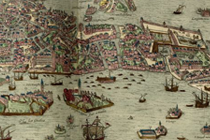Bringing The Renaissance To Life
February 18, 2015

ARHU students win $25,000 seed grant to fund interactive website using primary resources.
Imagine strolling through Renaissance Venice, exchanging between historical currencies like ducats and florins while shopping for ingredients to cook a traditional, Old World meal.
An interactive website being developed by a group including several students from University of Maryland’s College of Arts and Humanities aims to make that trip back through the centuries a reality. Called Through Venetian Eyes, students behind the website were one of four groups chosen to receive a $25,000 Future of Information Alliance seed grant from the Robert W. Deutsch Foundation after developing and pitching their idea during a competition late last year. The competition is designed to bring teams of students together on research projects intended to solve key-information related challenges.
The students plan to use primary resources found via partners including the Library of Congress (LOC), the National Archives and the Centro Interuniversitario per la Storia di Venezia in Italy to bring the Renaissance to life via multimedia presentations on the Internet. Primary sources help provide first-hand accounts of what everyday life would have been like during the period, as opposed to having to read summarized textbook versions, Andrew Ethnasios, project manager and partner coordinator, said.
“I want Through Venetian Eyes to make people realize that history is not boring,” Ethnasios, a junior studying Middle Eastern history, said.
Other students working on the project include Henry Twist, a junior studying Latin American culture and education who is handling content acquisition and archives research; Brandon Perlman, a senior studying government and politics, who is also handling content acquisition and archives research; Ashley Vogel, a junior in Jewish studies, handling web layout and archives research and Karl Dempsey, a senior studying Middle Eastern history, who is handling filming, editing and archives research. Kate Bailey, a Ph.D candidate in the Department of History, serves as the project's research advisor. Associate Professor of Jewish History Bernard Cooperman and Stefano Villani, associate professor of history, are their faculty mentors.
"These ambitious students are leveraging the locational advantages of our campus to draw on the area's rich cultural resources,” Cooperman said. “They intend to dig deep and then make their findings widely available and accessible. Their project can provide a model of research and publication method for future courses around campus. By creating this project, the students aspire to be not just consumers of knowledge but producers of it as well."
Students will spend the next few months developing the website while simultaneously combing through archives to develop four to seven topics to highlight. One idea is to provide an interactive currency calculator using archival inventory lists with which to exchange florins for ducats. Another might provide recipes—including one for a traditional cookie called Ginetti Di Sukkot--that users may then update and upload to highlight evolving taste trends or diets, particularly the popular gluten-free movement, Ethnasios said. Research already done within the LOC’s divisions have so far revealed a hand-drawn map of the city from 1612 as well as music composed inside Venice’s Jewish ghetto. Students are also highlighting the ghetto—the first of its kind—to show how the predominantly Christian city controlled its spaces and helped to further the idea of minority cultures, Ethanasios said.
“We want this project to show that primary sources don’t bite,” he said.
Students chose Venice because of the availability of information about the city, which was a global trading market and a bastion of arts and culture, Ethnasios said.
“By partnering with numerous cultural institutions including the Library of Congress and the National Archives, Through Venetian Eyes aims to provide students with a richer and more diverse collection of primary resources on Renaissance Italy than exists today,” Anne Rose, FIA managing director said. “Detailed pictures of our past can be used to better understand the present and inform our future.”
A final presentation for all grant winners is planned in May.
Learn more about Through Venetian Eyes as the site develops: update.throughvenetianeyes.org.

